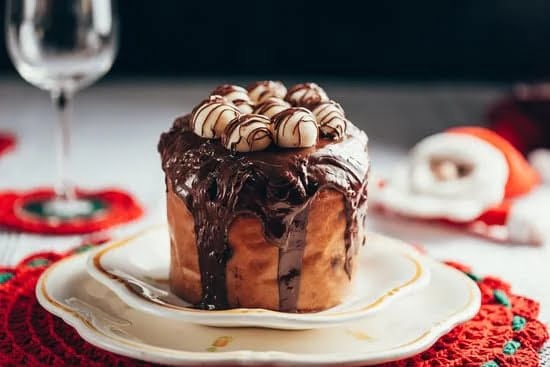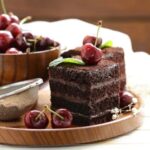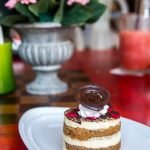Decorating mini cakes has become a trendy and fun hobby for many people. The appeal of these petite treats lies in their charming presentation and the endless creative possibilities they offer. Whether you’re a baking enthusiast looking to expand your skills or simply someone who enjoys making beautiful and delicious desserts, decorating mini cakes is an exciting venture that can be enjoyed by anyone.
Mini cakes are not only adorable but also versatile. They can be customized for various occasions such as birthdays, weddings, baby showers, or even just as a sweet gift for a loved one. With their small size, they provide the perfect canvas for intricate designs and personalized touches.
One of the great things about decorating mini cakes is that it doesn’t require a professional level of skill or experience. Even beginners can dive into this hobby with ease. All you need are some basic tools and ingredients to get started. From there, you can learn different techniques, experiment with flavors and colors, and let your imagination run wild.
In this article, we will guide you through the art of decorating mini cakes step by step. We’ll cover everything from baking the perfect base cake to mastering various decoration techniques using buttercream, fondant, and other decorative elements. We’ll also share troubleshooting tips for common challenges you may encounter along the way.
So if you’re ready to embark on a deliciously creative adventure and unlock your inner pastry artist, let’s dive into the world of decorating mini cakes.
The Essential Tools and Ingredients for Decorating Mini Cakes
When it comes to decorating mini cakes, having the right tools and ingredients is essential for success. Whether you are a beginner or an experienced baker looking to try your hand at mini cake decoration, this guide will help you get started with the essentials.
One of the most important tools for decorating mini cakes is a set of piping tips and bags. These allow you to create different designs and textures with buttercream frosting. Look for a set that includes various tip sizes and shapes, such as round tips for creating borders, star tips for rosettes, and leaf tips for adding foliage details. Additionally, make sure to have both reusable piping bags and disposable ones on hand for easy clean-up.
In addition to piping tips and bags, having a turntable is crucial for smooth and precise decorating. A turntable allows you to easily rotate your cake while working on it, ensuring that every angle is accessible. Look for one with a non-slip base to provide stability during decorating.
When it comes to ingredients, high-quality butter and powdered sugar are essential for making smooth buttercream frosting. Be sure to use unsalted butter as salted butter can alter the taste of your frosting. Additionally, invest in good quality food coloring gels or pastes instead of liquid food coloring as they provide more vibrant colors without thinning your frosting.
By investing in these essential tools and ingredients, you will be well-prepared to embark on your mini cake decorating journey. Remember, practice makes perfect, so don’t be afraid to experiment with different techniques and designs as you create beautiful edible works of art.
Step-by-Step Tutorial
Mini cakes are not only delicious treats, but they also provide the perfect canvas for creativity and self-expression through decoration. Whether you are a seasoned baker looking to try something new or a beginner eager to learn, this step-by-step tutorial will guide you through the process of baking the perfect mini cakes for decorating.
To start, gather your ingredients: flour, sugar, eggs, butter, milk, vanilla extract, baking powder, and salt. Preheat your oven to the recommended temperature stated in your recipe.
- Prepare the batter: In a large bowl, cream together the butter and sugar until light and fluffy using an electric mixer. Add in the eggs one at a time, beating well after each addition. Mix in the vanilla extract.
- Fill your mini cake pans: Grease your mini cake pans with butter or cooking spray. Spoon the batter into each cavity of the pan until it is about two-thirds full.
- Bake and cool: Place the pans in the preheated oven and bake for the amount of time specified in your recipe or until a toothpick inserted into the center comes out clean. Once they are baked to perfection, remove them from the oven and let them cool in their pans for about 10 minutes before transferring them onto a wire rack to cool completely.
2. In a separate bowl, whisk together the dry ingredients – flour, baking powder, and salt. Gradually add the dry mixture into the wet ingredients alternatively with milk until just combined.
By following these simple steps, you can ensure that your mini cakes have a moist and fluffy texture as a base for your decorative creations. Remember to fully cool them before moving on to applying frosting or decorations to prevent any melting or smudging of your designs.
Mastering the Art of Buttercream
Buttercream is one of the most versatile and popular frosting options for decorating mini cakes. With its smooth texture, creamy taste, and ability to hold shape, buttercream allows for endless creativity in cake decoration. Whether you’re a beginner or an experienced baker, mastering buttercream techniques can take your mini cake decorations to the next level. Here are some essential tips and techniques to help you become a buttercream pro:
1. Preparing the perfect buttercream: The key to achieving a smooth and creamy buttercream is ensuring that your ingredients are at room temperature. Softened butter will cream much more easily with sugar, resulting in a smoother texture. Sift your powdered sugar before adding it to the butter to avoid any lumps in the frosting. Additionally, adding a pinch of salt can enhance the flavor and balance out the sweetness.
2. Piping techniques: Piping is an essential skill for creating beautiful designs on mini cakes with buttercream. To start, make sure that your piping bag is fitted with a desired tip. There are various tips available, such as round tips for creating dots or writing, star tips for creating rosettes or shells, and petal tips for creating floral designs. Practice different pressure techniques to control the flow of icing while piping onto your mini cakes.
3. Coloring and flavoring: Buttercream provides an excellent canvas for incorporating flavors and colors into your mini cake decorations. To color your buttercream, use gel food coloring as it produces vibrant shades without thinning out the consistency of your frosting. Start with small amounts of color and gradually add more until you achieve the desired shade. Experiment with different extracts like vanilla, almond, or citrus to infuse unique flavors into your frosting.
By mastering these techniques and tips, you can create visually stunning mini cakes using buttercream. Remember to practice your piping skills and experiment with different designs to unleash your creativity. With patience and practice, you’ll soon be wowing friends and family with your beautifully decorated mini cakes.
Unlocking Your Creativity
Decorating mini cakes is not only a delicious hobby but also a great way to showcase your creativity. Whether you are baking these treats for a birthday party, a wedding, or just as a special treat for yourself, there are countless ways to make them visually appealing and unique. In this section, we will explore some inspiring mini cake decoration ideas for different occasions, helping you unlock your creativity and impress your guests.
Birthday Cakes
Birthdays are the perfect occasion to let your imagination run wild and create fun and festive mini cake designs. Consider incorporating the birthday person’s favorite colors, hobbies, or interests into the design. For example, if they love animals, you can decorate the mini cakes with adorable animal faces using colorful buttercream icing. You can also add edible sprinkles in the shape of numbers or letters to represent their age or initials.
Wedding Cakes
Mini cakes can be an elegant and charming option for weddings. To create a sophisticated look, consider using delicate floral decorations made from fondant or gum paste. You can use edible pearls or gold leaf to add an extra touch of luxury. Another idea is to stack multiple mini cakes on each tier of a stand, creating a miniature multi-tiered wedding cake display. Decorate each cake with simple yet elegant icing designs such as lace patterns or monogrammed initials.
Holiday-themed Cakes
Mini cakes are also wonderful for celebrating holidays and seasonal events. For Christmas, you can decorate mini cakes in the shape of ornaments, snowflakes, or reindeer using colored fondant or royal icing. Halloween offers opportunities for spooky designs such as jack-o’-lanterns or black cats made from chocolate ganache or black fondant. Experiment with different flavors like pumpkin spice for autumn-themed cakes or peppermint for winter holidays.
Special Occasions
There are many other special occasions that deserve beautifully decorated mini cakes. For baby showers, consider using pastel colors and decorating with cute baby-themed designs like onesies or strollers. Anniversary celebrations can be marked with elegant designs, such as edible gold accents or romantic floral patterns. Valentine’s Day calls for heart-shaped mini cakes decorated with vibrant reds and pinks, while graduation parties can feature cap and diploma designs in the school colors.
The key to unlocking your creativity when it comes to mini cake decorations is to let your imagination take flight. Experiment with different techniques, flavors, and designs to create unique and personalized creations for any occasion. Whether you are a beginner or an experienced baker, decorating mini cakes allows you to express yourself artistically while satisfying your sweet tooth.
Beyond Buttercream
Decorating mini cakes goes beyond just using buttercream icing. To truly elevate your mini cake creations, it’s important to explore other decorative techniques and materials such as fondant. Fondant is a smooth and versatile icing that allows for more intricate designs and a polished finish. In this section, we will delve into the world of fondant and other decorative techniques that will take your mini cakes to the next level.
Fondant is a type of icing that can be rolled out like dough and draped over the cake to create a smooth and flawless surface. It provides a clean canvas for more detailed decorations such as flowers, bows, or intricate patterns. To work with fondant, you will need some additional tools including a rolling pin, cornstarch or powdered sugar for dusting, and fondant shaping tools for sculpting delicate designs.
One key tip when working with fondant is to roll it out on a smooth surface using powdered sugar or cornstarch to prevent sticking. Also, make sure to cover your hands with shortening to avoid leaving fingerprints on the fondant. Once rolled out, drape it over your mini cake smoothly, gently smoothing out any wrinkles or air bubbles with your hands or a fondant smoother tool.
Aside from fondant, there are other decorative techniques you can explore for your mini cakes. One popular technique is piping royal icing onto the cake to create intricate designs or words. Royal icing is made by combining powdered sugar and egg whites until stiff peaks form. It can be used in varying consistencies depending on the desired effect – thicker consistency for outlining and thinner consistency for filling in.
Another technique is using edible glitter or luster dust to add shimmer and sparkle to your mini cakes. These edible powders come in various colors and can be brushed onto the fondant or buttercream using a soft bristle brush. This adds an elegant touch to your designs and makes them stand out.
By exploring fondant and other decorative techniques such as piping and edible powders, you will unlock endless possibilities for creating stunning mini cake designs. These techniques allow you to add intricate details, texture, and sparkle to your creations, making them truly eye-catching. So, venture beyond buttercream and let your creativity run wild with these exciting decorative options for your mini cakes.
Troubleshooting Common Decorating Challenges
Decorating mini cakes can be a delightful and creative hobby, but it’s not without its challenges. Two common problems that decorators often face are cracked fondant and smudged buttercream. However, with the right techniques and solutions, these issues can be easily overcome to achieve professional-looking results.
One of the most frustrating situations for decorators is when their fondant cracks as they try to cover their mini cakes. This can happen due to various reasons, such as improper handling or rolling out the fondant too thin. To prevent cracked fondant, it’s essential to ensure that your mini cakes are properly chilled before covering them with fondant. This will help the icing set and hold its shape better.
Another solution to prevent cracking is to roll out your fondant evenly and avoid stretching it too much while covering the cake. Applying a light layer of shortening or cornstarch on your work surface and rolling pin can also help prevent sticking and tearing. Additionally, you can use a smoother tool or gently massage the surface of the cake once the fondant is applied to smooth out any imperfections or small cracks.
Smudging buttercream while decorating mini cakes is another common challenge that decorators encounter. This can occur when using too much pressure while piping or accidentally touching the buttercream with your fingers or tools before it has fully set. To avoid smudging, make sure that your hands are clean, dry, and free from excess frosting. Use gentle pressure while piping or spreading buttercream onto your mini cakes, ensuring that you have good control over your tools.
To fix smudges on buttercream decorations, you can use a small offset spatula or a clean finger dipped in warm water to carefully smooth out any imperfections or fingerprints. If you’re working with multiple layers of buttercream decorations, allow each layer to set before adding the next one to avoid accidentally smudging the previous design.
Overall, practicing patience, using proper techniques, and having a steady hand are crucial for troubleshooting and fixing common decorating challenges such as cracked fondant and smudged buttercream. With these solutions in mind, you’ll be well on your way to mastering the art of mini cake decoration and creating beautiful and visually appealing treats.
| Common Decorating Challenges | Solutions |
|---|---|
| Cracked Fondant | – Ensure cakes are properly chilled before covering with fondant
|
| Smudged Buttercream | – Keep hands clean, dry, and free from excess frosting
|
Elevating Your Mini Cake Game
Use Proper Piping Techniques
One of the key elements in achieving professional-looking decorations on mini cakes is mastering piping techniques. Whether you are using buttercream or royal icing, using the right piping tip and practicing different designs can greatly enhance the overall look of your decorated mini cakes. Start by familiarizing yourself with basic piping tips such as round, star, and petal tips.
Practice creating different shapes, lines, and textures to add variety to your decorations. Remember to apply consistent pressure when piping and practice steady hand movements for clean and precise designs.
Embrace Texture and Dimension
Adding texture and dimension to your mini cake decorations can elevate them from ordinary to extraordinary. Experiment with different techniques such as ruffles, rosettes, or piped flowers to create depth and visual interest on your mini cakes. You can also incorporate edible embellishments like sprinkles, edible pearls, or gold leaf to add a touch of glamour. Don’t be afraid to mix different textures together or combine different decoration techniques to create unique and eye-catching designs.
Pay Attention to Color and Contrast
Color plays a crucial role in creating visually appealing mini cake decorations. To achieve professional-looking results, pay attention to color combinations and contrast. Choose a color palette that complements each other well or opt for contrasting colors for a bold statement. Consider using color theory principles such as the color wheel or color harmony techniques like monochromatic or complementary colors. Play around with shades, tints, or ombre effects to add depth and visual interest.
Invest in Quality Tools
Investing in high-quality decorating tools can significantly improve the final result of your mini cake decorations. Look for sturdy piping bags that are comfortable to hold during long decorating sessions. Choose stainless steel piping tips that are durable and rust-resistant.
Additionally, having a rotating cake turntable can make the decorating process much easier and allow you to achieve smoother and more precise designs. Quality tools not only enhance the overall appearance of your mini cakes but also provide better control and ease of use.
By implementing these pro tips into your mini cake decorating process, you can take your skills to the next level and achieve professional-looking decorations that will impress friends and family. Remember, practice makes perfect, so don’t be discouraged if your first attempts don’t turn out exactly as planned. Keep experimenting, learning new techniques, and most importantly, have fun with your mini cake creations.
Sharing the Love
Once you have mastered the art of decorating mini cakes, you may find yourself wanting to share your creations with others. Whether it’s for a special occasion or just to spread some joy, there are many creative ways to gift and display your decorated mini cakes.
One popular option is to package your mini cakes individually and give them as party favors or gifts. To do this, you will need small boxes or cellophane bags that are the right size for your mini cakes. You can find these at most craft stores or online.
Place each mini cake in its own box or bag, making sure it is secure and won’t shift during transportation. You can then tie a ribbon around each package or attach a small personalized tag to add an extra touch.
Another fun way to share your decorated mini cakes is by hosting a cake tasting party. Invite friends or family over and display all of your mini creations on a dessert table. Provide small plates and utensils so that guests can sample different flavors and designs. This is not only a great way to showcase your skills, but also an opportunity for others to appreciate and enjoy your delicious creations.
If you want to give someone a larger display piece instead of individual mini cakes, consider creating a tiered cake stand using foam blocks covered in decorative paper or fabric. Arrange the mini cakes on the stand in an aesthetically pleasing way, with taller ones in the back and shorter ones in the front. This will create a visually stunning centerpiece that is sure to impress.
Conclusion
Decorating mini cakes is not only a trendy and fun hobby, but it also offers a rewarding and versatile skill to have. Throughout this article, we have explored the essential tools, ingredients, and techniques for decorating mini cakes. We learned how to bake the perfect mini cakes, master the art of buttercream, explore fondant and other decorative techniques, troubleshoot common challenges, and elevate our mini cake game with professional-looking decorations.
One of the reasons why decorating mini cakes is so rewarding is because it allows us to unleash our creativity. We have discussed inspiring ideas for different occasions, such as birthdays, weddings, and holidays. The possibilities are endless when it comes to designing and personalizing each mini cake. From intricate piping designs to delicate fondant details, you can truly express your artistic talents through this form of edible art.
Furthermore, decorating mini cakes provides an opportunity to share joy and love with others. We have explored creative ways to gift and display our decorated masterpieces. Whether it’s surprising a loved one with a box of beautifully decorated mini cakes or showcasing them at special events or celebrations, these personalized treats are sure to bring smiles and happiness.
In conclusion, decorating mini cakes is not just a trendy hobby; it is a skill that brings joy both to the baker and those who enjoy the delicious creations. With patience, practice, and a sprinkle of creativity, anyone can become skilled in this art form. So gather your tools, unleash your imagination, and dive into the world of decorating mini cakes – you will be amazed at what you can achieve.
Frequently Asked Questions
How to decorate a mini cake?
Decorating a mini cake can be a fun and creative activity! Start by preparing your mini cake with a smooth layer of icing, using a spatula or piping bag. Then, consider adding decorative elements such as colorful sprinkles, edible flowers, or chocolate shavings.
You can also personalize your mini cake by writing a special message with icing or incorporating fondant decorations. Don’t be afraid to experiment with different techniques like piping designs or creating small fondant figurines to make your mini cake truly unique.
What can I put on a cake instead of frosting?
If you’re looking for alternatives to traditional frosting for your cake, there are several delicious options available. One option is whipped cream, which can be lightly sweetened and flavored with vanilla extract or other extracts of your choice. This creates a lighter and fresher taste compared to buttercream frosting.
Another alternative is ganache, which is made from mixing heated heavy cream with chopped chocolate until smooth and glossy. Ganache adds an elegant touch while providing a rich and decadent flavor. Additionally, cream cheese icing provides a tangy and creamy alternative that pairs well with various flavors like carrot or red velvet cakes.
How do you make a plain cake look fancy?
To make a plain cake look fancy, you can utilize various techniques to enhance its appearance without relying solely on intricate decorations. Begin by leveling the top of the cake layers to create an even surface. Next, consider using simple yet elegant garnishes such as fresh fruit slices arranged in an appealing pattern on top of the cake.
Alternatively, brushing the cake layers with simple syrup infused with flavors like citrus or liquor can add moisture while imparting an extra touch of sophistication. Dusting the finished cake lightly with powdered sugar or cocoa powder through a fine-mesh sieve gives it an effortless elegance perfect for any occasion. Finally, consider adding texture by applying a smooth layer of buttercream icing around the sides and using comb-like tools to create patterns for additional visual interest on the finished product.

Welcome to our cake decorating blog! My name is Destiny Flores, and I am the proud owner of a cake decorating business named Cake Karma. Our mission is to provide delicious, beautiful cakes for all occasions. We specialize in creating custom cakes that are tailored specifically to each customer’s individual needs and tastes.





